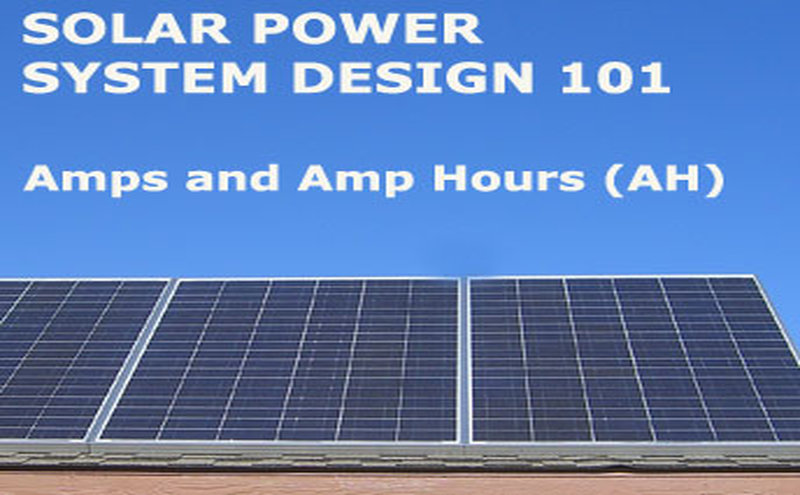Solar Power System Design 101 (Amps and Hours AH)

One of the ways that batteries are rated is something called ‘Amp Hours’, also referred to as AmpHours, or simply ‘AH’. This is true of ALL batteries regardless of their size or shape. This rating is one of the core ratings that you need to be aware of when designing any solar power system and its battery bank storage capability, regardless of its intended size and capability.
The AH rating of a rechargeable battery helps us to determine how long it will last before losing its charge, and will help determine how long it will take to charge up again.
In order to grasp what this really means, we need to understand some very basic things about electricity, one of which is called ‘Amps’. Think of Amps as the amount of ‘juice’ that’s flowing. It’s similar to the water that flows through a hose. If the hose is shut off and no water is flowing, the flow is zero. If your electrical device is shut off, the ‘Amps’ are zero. Think of this as current. Electrical current. Current flows, and it flows at different speeds. Sometimes the current flow stops. Same with electricity. Amps are current flow.
A charged battery has energy stored inside of it. When a battery is hooked up to a circuit or device or system, it will provide current in the form of Amps when it’s turned on. If the device or system demands a-lot of energy to run, then the battery will draw down faster because lots of Amps are flowing out of it. It all depends upon the device(s) that you are running off the battery or battery bank as to how long it will last.
Here are some examples…
Say that a certain 12-volt heavy duty deep cell battery is rated at ‘200 AH’. This means that this battery will provide 12-volts of electricity for 200 hours at 1 Amp of current. There is more to it than this simple example (the way that they actually rate these batteries under certain conditions), but for the sake of simplicity and ‘good enough’, this is the case. This same battery will also provide 20 Amps of current for 10 hours before it’s completely drained. See how the rating works? Pretty simple…
How does this help us? Well, if we know what this battery will be hooked up to, and we know the amount of current (Amps) that a device demands in order to run, then we can figure out how long to expect this battery to provide ‘juice’ before it needs to be recharged.
Note this… when it comes to your typical 12-volt deep-cell battery (typically used for alternative energy storage), you NEVER want to discharge the batteries completely. If you do, you could destroy them ($ cha-ching). The less you discharge the batteries before you recharge them, the longer they will last overall. A good rule of thumb is to never go below 20% remaining (or 80% discharge). In fact, the systems that I have built, I try to limit discharge to 50%, maybe 70% tops.
Lets say you want to use your 12-volt deep cell battery storage to power up three 12-volt light bulbs of the typical variety that you find in trailers these days (e.g. a C921). This tungsten-style bulb draws 1.4 amps. Since you have three, 3 x 1.4 = 4.2 amps total. So, lets say you only want to allow your 200AH battery to draw down to only 50%. That leaves a total of 100 Amp Hours available to consume. So, 100 / 4.2 = 23.8, which means that you can run these three bulbs for just about 24 hours.
Note this… Seeing how you can only run them for 24 hours, what if you decided to replace your C921 bulbs with an LED-style replacement? LED bulbs draw much less power. I mean a-lot less. In this particular example, a near exact replacement for the parameters of the C921 bulb brightness (lumens) and color temperature happens to be a 5050131. I know this because I’ve replaced all of the C921’s in my 5th-wheel. The current draw of this LED is only 0.23 amps, so in the example of three bulbs, 3 x 0.23 = 0.69 amps. So, the available 100 Amp Hours from the battery divided by 0.69 equals 145 Hours!! Big difference.
As you can see, understanding the relationship between battery ‘Amp Hours’ and the device or devices that you wish to power, helps you determine how long to expect them to run.
In other articles we will talk about ‘Watts’ and ‘Volts’ which are related to ‘Amps’. Actually, by understanding these three things and how they interact, is mostly all you need to know about very basic electricity and to be able to piece together the basic parts of a solar power system. There’s much more of course, but I’m just saying…
Survival preparedness and self-reliance is a life style that encompasses many things, including the topic of energy. One of my many interests is alternative energy, namely, solar power. This article along with others in this titled series, is intended to provide simple, basic, easy to understand instructions, methods, tips, and examples for those who are interested in a series of helpful ‘101’ type information in this area. Remember though… electricity can be dangerous. Consult a professional. Do your own due-diligence regarding any information contained within this page ;)
